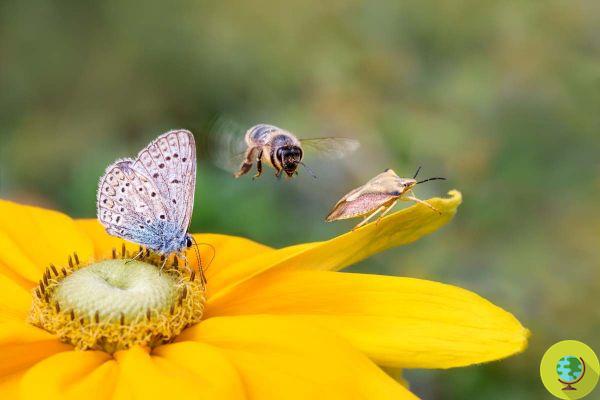
On the occasion of Cop15, scientists take stock of the main threats to biodiversity on which to intervene as soon as possible.
From air pollution to land consumption, here are the main threats to biodiversity identified by scientists and what measures should be taken by countries to stop them.
While negotiations for the Cop15, the UN conference on biodiversity, scientists took stock of the major ones environmental threats to be faced as soon as possible to save the Planet and all living beings who inhabit it.
During the talks scheduled by COP15 in Kunming, China, the policies to be put in place to curb the loss of biodiversity. The wildlife population has declined by more than two-thirds since 1970 and the trend shows no sign of slowing down.
According to scientists from IPBES (Intergovernmental Science-Policy Platform on Biodiversity and Ecosystem Services) there are five key aspects to be addressed to protect biodiversity: land consumption and water use, exploitation of natural resources, global warming, pollution and invasion of alien species.
Index
Land consumption
By mapping the expansion and abandonment of land, scientists realized that in just over a decade and in the United States alone, 4 million hectares of grasslands have been destroyed. The land was used for make way for crops, especially wheat, soy and corn.
To destroy natural habitats it is the first threat to biodiversity: every time a land is converted for agriculture, butterflies, songbirds, migratory birds, mammals and of course plants are lost.
Reduce land use and change the way we use it - for example by finding solutions for increase yield of already cultivated land - is what we need to start from to protect biodiversity, according to scientists.
Exploitation of water resources
Deforestation, extraction of oil and gas, exploitation of water resources, but also hunting and fishing, have a devastating impact on the life of the Planet.
The consequences of these activities are often clearly visible, while in some cases the crisis they generate is not perceived, as in the case of the exploitation of water resources by farmers and mining companies.
Pumping water from underground storage a unsustainable rhythms as we are doing, it has caused and continues to cause the drying up of rivers and the loss of biodiversity in freshwater and this threatens global food security.
According to scientists, by 2050 percentages between 42% and 79% of groundwater globally they could shrink so much to exceed points of no return ecological. It is therefore a priority to intervene to improve the use of groundwater by making the water supply more efficient to avoidexhaustion of resources.
Global warming
Global warming directly and indirectly threatens life on the planet. In 2019, the wave of record heat which overwhelmed Europe has recorded temperatures over 40 ° C in several countries, including France. In Montpellier, the soaring temperatures have resulted in the deaths of numerous great tit chicks in at least thirty nests. Last summer, thermometers hit new records; the exaggerated heat was joined by fires that have devastated animal and plant life in various countries around the world.
Read also: Record heat in Europe: the summer of 2021 was the hottest of the last 30 years
Global warming alters the trend of rains bringing to drought and increasingly extreme weather phenomena. Furthermore, the increase in temperatures is linked to sea level rise and ocean warming, with obvious dramatic consequences for terrestrial and marine ecosystems.
Global warming is therefore added to the destruction of habitats and the exploitation of resources, a fundamental aspect on which to intervene to save biodiversity.
Pollution
Pollution is literally devouring biodiversity, causing the loss of plant and animal species. The problem concerns air, water and soil pollution and is related to waste but not only.
In addition to plastic pollution, which is clearly visible and known, biodiversity is seriously threatened bynitrogen pollution which comes from intensive agriculture and the use of fossil fuels. Nitrogen is destroying numerous animal and plant species, even far from sources of pollution.
To reduce the amount of nitrogen that flows from cultivated fields to watercourses, it is necessary to reduce the use of nitrogen fertilizers and cultivated fields, goals that could be achieved by limiting waste in the agricultural sector and meat consumption from all of us.
Invasive species
Invasive plant and animal species are the latest urgent threat to be addressed in order to protect biodiversity. The populations native speciesin fact, they are literally decimated by alien species introduced accidentally or on purpose by us human beings.
On Gough Island in the South Atlantic Ocean, dozens of seabird chicks are eaten by rats each year, for example, introduced by sailors in the XNUMXth century. The mouse population, finding no predators, has increased dramatically, putting the Tristan albatross and dozens of other rare seabirds at risk.
When a invasive species endangers native species, the solution is often to capture and kill alien animals and this clearly triggers protests from environmentalists. Rather than killing entire populations of animals without blame, one solution would be to sterilize individuals so that they can control their expansion.
Read also: "The Region face to face": the heartfelt appeal of Bodies and associations against the killing of gray squirrels in Emilia Romagna
Follow us on Telegram | Instagram | Facebook | TikTok | Youtube
Sources of reference: Zenodo / The Guardian
Read also:
- BigPicture Natural World Photography 2021: Winning Photos Celebrate Biodiversity and Show the Threats Rocking the Planet
- Human-wildlife conflict is one of the most serious threats to biodiversity
- Biodiversity: the 2021 Directive has been signed which protects bees and corals, but only in already protected areas


























